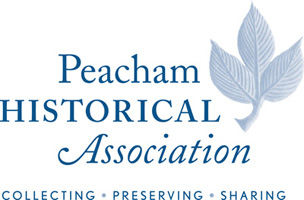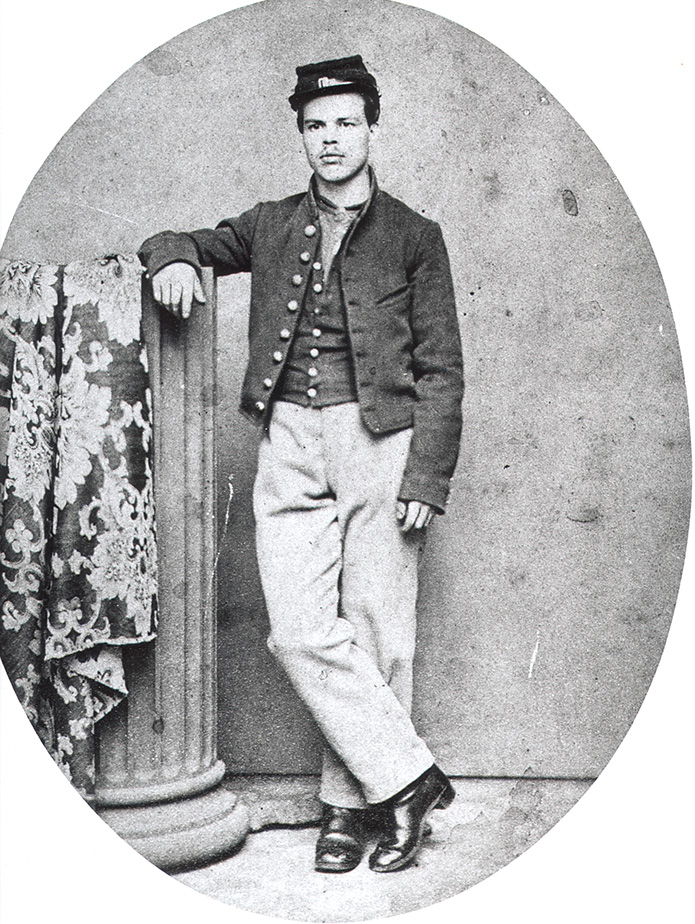Letters From the Front: Private Hazen Blanchard Hooker, Co. G, Third Vermont Regiment
The transcriptions and digital facsimiles of Hazen’s 75 letters are now available on the Vermont in the Civil War website. The direct link to the letters is: http://vermontcivilwar.org/units/3/Hooker/index.php
Collection Overview
Hazen Blanchard Hooker was born in Peacham on December 18, 1842, the son of farmers Orman P. and Mercy (Blanchard) Hooker. He worked on his parents’ farm until his enlistment. He enlisted four months before his 20th birthday on August 8, 1862 and served in Co. G, Third Vermont Regiment, together with six other Peacham boys, including his friend Lucius O. Morse with whom he shared a tent. In March 1863, Hazen contracted typhoid fever and spent more than a month in the hospital. He returned to his regiment in July. He participated in several battles in Virginia- among them were the First and Second Fredericksburg battles. Hazen was the first Peacham-born boy killed in action, dying on the first day of the Battle of the Wilderness on May 5, 1864. He is buried on the field of battle. His name is inscribed on the Peacham Soldiers Monument.
During his two years of service, Hazen wrote extensively to his parents, grandparents, and friends. His seventy-five letters were originally transcribed by Lynn A. Bonfield between 1998 and 2002. In 2012, a grant from the Vermont Humanities Council and the National Endowment for the Humanities supported the preservation and digital imaging of the letters. The digital facsimiles were used to review and make minor corrections to the initial the transcriptions. All letters are preserved in the collections of the Peacham Historical Association. Visit the Vermont in the Civil War website for the transcriptions and digital images of his letters. Six letters are reprinted in “A Vermont Hill Town in the Civil War: Peacham’s Story”.
Use of the Hazen Blanchard Hooker Letters
Images and transcriptions may not be reproduced without formal permission from the Peacham Historical Association. Permission must be obtained in writing from the Peacham Historical Association.
Mark Wheeler: a Civil War Memoir
Mark Wheeler was a twenty-two-year-old Peacham farmer when he enlisted in November 1861. He served in the First Vermont Cavalry, fought in battles at Bull Run, Gettysburg, Cold Harbor and numerous other skirmishes. He was taken prisoner in the Richmond/Petersburg Campaign during a fight at Stony Creek on June 29, 1864. He spent five months in four different Confederate prisons. The worst was the Confederate prison at Andersonville where he was for four months until October 1864. He was paroled in November 1864 and returned to Peacham in December.
This electronic archive presents the detailed reminiscences written by Mark Wheeler. Our website features the transcribed text version, the electronic images of the original manuscript, and biographical information.
The preserved original manuscript is held in the collections of the Peacham Historical Association. The manuscript consists of 55 two-sided, loose, handwritten pages, measuring 7 ½ inches in length and 5 1/8 inches in width. The major portion of the manuscript describes his life inside the Confederate prison at Andersonville during the summer and fall of 1864 when more than 32,000 prisoners were held in the 26-1/2 acre stockade.
The preservation and digitization of the manuscript was supported through a grant from the Vermont Humanities Council and the National Endowment for the Humanities.
The Text Version
The transcribed text version of Mark Wheeler’s memoir is the work of a dedicated volunteer, Michelle Arnosky Sherburne. She spent numerous hours transcribing verbatim Mark Wheeler’s 105 handwritten pages, making no attempt to correct Mark Wheeler’s spelling or grammar. Misspelled words that sound like or look like the intended words have been transcribed as Mark Wheeler wrote them. He frequently crossed out words and inserted corrections, and these are shown in the text with strikeouts or as superscript inserts to reflect his method of writing. Place names with variant spellings and inconsistent capitalization have been left largely as they appear. In a few cases of challenging misspellings, the inferred word or correct place name are supplied in brackets as superscripts. Brackets are also used to supply missing letters and words or to expand confusing abbreviations.
Although the transcribed text preserves Mark Wheeler’s misspellings, inconsistent spellings and grammar with minimal editorial intrusion, no attempt was made to replicate the physical appearance of the manuscript. While Mark Wheeler’s handwriting is reasonably clear, his frequent corrections, random ink marks, insertions, and erasures could not be visually captured in the transcript. The text version retains the page breaks, but it does not provide a line-by-line transcription. Words divided at the end of a line are transcribed with the dash as used in the original. Since the manuscript lacks punctuation, three spaces are inserted for easier reading to indicate breaks in the stream of thought and to mark the end of a sentence. Endnotes provide background information about places, people or events described in the manuscript.
The Image Version
Mark Wheeler’s original manuscript is displayed in three separate parts. The electronic images were scanned in July 2009 by the Digital Services Department at the Northeast Document Conservation Center (NEDCC) in Andover, MA. The images are divided into three smaller, browsable PDF files. You can also view the December 30, 1864 article from the Caledonian Record that he copied at the end of his manuscript, but in the original the pages have deteriorated over time and are no longer fully legible.
Image version of original manuscript – Part 1
Image version of original manuscript – Part 2
Image version of original manuscript – Part 3
Caledonian-Record – Dec 30, 1864
Use of the Mark Wheeler Memoir
Images and transcription may not be reproduced without formal permission from the Peacham Historical Association. Permission must be obtained in writing from the Peacham Historical Association.


